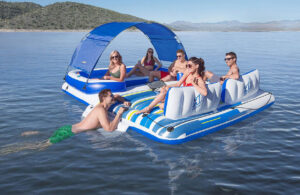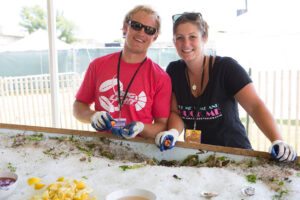According to legend, the ancient Roman hero Hercules founded a famous Greek sporting festival in Olympia. Fast forward nearly three millennia, and the modern-day Olympics were revived in Athens in 1896.
Jump forward again to the Tokyo 2020 Olympics (postponed until 2021 due to COVID-19), which will be among the largest games with 33 competitions and more than 300 events held in 40+ Japanese venues. Water sports make up 10 contests.
Spectators are not allowed due to the pandemic, so the only way to cheer on Team USA athletes is via TV and other media. NBC Sports Group will broadcast the Olympics in America (nbcolympics.com), and each national body will also provide social media updates.
To get ready for the summer games, here’s a primer on what and who to watch.
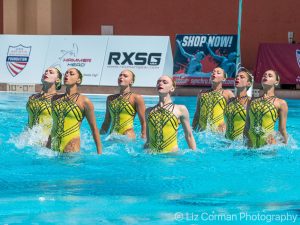
ARTISTIC SWIMMING
Tokyo Aquatics Centre, August 2-7
First called synchronized swimming when it debuted at the 1984 games, this sport and rhythmic gymnastics are the two women-only Olympic disciplines. The United States proved the first powerhouse country, winning both the duet and team categories in 1984 and 1996. This year’s eight-woman U.S. team is one of the youngest, averaging age 19, but one member, Anita Alvarez, competed in the 2016 games.
“Our sport combines artistic elements of dance and gymnastics with an intense foundation of athleticism built by many hours spent training on land and in the pool,” says Alyssa Jacobs, communications and partnership marketing coordinator for USA Artistic Swimming. Routines are centered around themes, and judging is based on technical execution of the swimming elements, synchronization, lifts and artistic impression. Recent leaders in the sport include Russia, China, Japan, Ukraine and Spain.
CANOE SLALOM
Kasai Canoe Slalom Centre, July 25-30
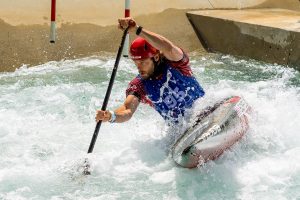
CANOE SPRINT
Sea Forest Waterway, August 2-7
Canoes and kayaks have been featured in mankind’s transportation toolbox since times B.C. The Canoe Sprint, where athletes paddle on short flatwater courses in a successive series of heats until the fastest wins, started as a demonstration sport at the 1924 Olympics and received medal- winning status in 1936. Athletes in Canoe Slalom, introduced at the 1972 Olympics, navigate up- and down-stream gates on a whitewater course in a race against the clock.
Tokyo could be a historic turning point for America according to Rok Sribar, general manager of high-performance programs for the American Canoe Association. “Nevin Harrison might be the first female gold medalist in the 200m event as women’s sprint canoeing makes its debut in Tokyo. Similarly, 17-year-old Evy Leibfarth could be the first U.S. athlete to win gold in slalom canoe or kayak.” The toughest competition to both will come from European athletes.
DIVING
Tokyo Aquatics Centre, August 2-7
Diving is a youth and family-oriented sport. At the Olympic level, it also captivates extreme sports fans with its precision, mid-air, visual appeal. None says this better than 10m platform dives where athletes can hit the water at nearly 35 miles per hour.
Most common are the solo and synchronized 3m springboard events. Each dive is assigned a degree of difficulty and scored on the approach, flight and water entry. United States has dominated the sport since its first games in 1904, racking up more than 100 medals since then.
“Four-time Olympic medalist David Boudia, who earned gold and bronze in 10m events, will compete in his first 3m dives in Tokyo,” says Kelly Fox, director of marketing and communications for USA Diving. The women’s platform divers have a strong chance at medaling for the first time since 2000 with a deep pool of talent including 2019 World Championship bronze medalist Delaney Schnell. In addition to America, China and Great Britain are nations to watch.
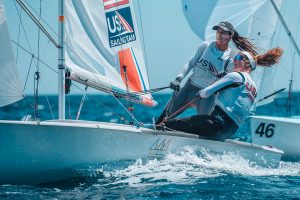
ROWING
Sea Forest Waterway, July 23-30
French-born father of the modern Olympics, Baron Pierre de Coubertin, made sure his favorite sport of rowing was included in the event’s 1896 revival, although it was canceled due to weather. Women’s events came seven decades later. In Tokyo, 14 boat categories in two disciplines – sweep rowing and sculling – will race on a 2,000m (1.25-mile) course.
“Rowing looks graceful, elegant and sometimes effortless when it is done well. Don’t be fooled. The sport demands endurance, strength, balance, mental discipline and an ability to continue when your body is demanding that you stop,” says Brett Johnson, senior director of programs and communications for the U.S. Rowing Association. Two U.S. athletes to watch: Kara Kohler, defending 2019 world champion bronze medalist in the women’s single sculls, and Dr. Genevra ‘Gevvie’ Stone, a 2016 silver medalist, who will race in the women’s double sculls. Past top medal-winning nations include Great Britain, Romania, Canada and the Netherlands.
SURFING
Tsurigasaki Surfing Beach, July 25-August 1
This ages-old board sport makes its Olympic debut at one of the farthest east beaches in Japan, known for its consistent Pacific Ocean swell. The two-and-a-half to four-day competition will take place anytime in an eight-day window when judges consider conditions are best. Initial rounds, composed of heats, will progress to gold, silver and bronze matches. Surfers are scored on quality (choosing the right wave and performing superior maneuvers) over quantity (surfing as many waves as possible).
“This venue has smaller wave conditions, so surfers with a strong air game will likely do well,” says Becky Fleischauer, communications specialist for USA Surfing. “Our team members have been training for these conditions both in wave pools and in the ocean, so they are in a strong position.” Team USA’s inaugural four Olympians represent both coasts: Florida’s Caroline Marks and California’s Kolohe Andino, as well as Hawaii’s John John Florence and Carissa Moore.
SWIMMING
Tokyo Aquatics Centre, July 24-August 1
MARATHON SWIMMING
Odaiba Marine Park, August 4-5
One of the original 10 sports at the first modern 1896 games, swimming is today second only to athletics in the sheer number of events. New in Tokyo is the men’s 800m freestyle, women’s 1500m freestyle, and the mixed 4×100m medley relay. This brings the contest count to 35 versus 32 in Rio in 2016. Scoring is all about speed: the first swimmer to touch the wall wins.
Australia, Japan, and Great Britain have strong swimming teams, yet America has dominated the podium and hardware count since 1960. “Olympic medal winners Ryan Murphy, Lilly King, and Kathleen Baker are back, and there are some incredibly talented up and coming swimmers that we hope make waves in Tokyo as well,” says Isabelle McLemore, managing director of communications at USA Swimming. Three U.S. athletes will race in the 10km open-water marathon swim, a discipline first added in the 2008 Olympics.
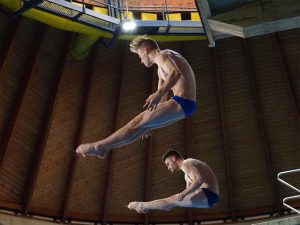
WATER POLO
Tatsumi Water Polo Centre, July 24-August 8
“This is a combination of many sports that fans already love, including soccer, hockey and basketball,” is how Greg Mescall, director of communications for USA Water Polo, likes to describe the sport. “It’s four quarters that are each eight minutes long, played in an all-deep pool with six field players and one goalie on each side. The most goals win.”
Water polo first entered the modern Olympic program in 1900. A century later, women’s water polo earned its medal-winning status. In Tokyo, the American women will attempt to be the first female water polo team to win three straight Olympic gold medals. They are already the first to win two straight Olympic golds. Australia, Spain and Hungary are the women’s chief challengers, with Hungary, Serbia and Croatia for the men.



